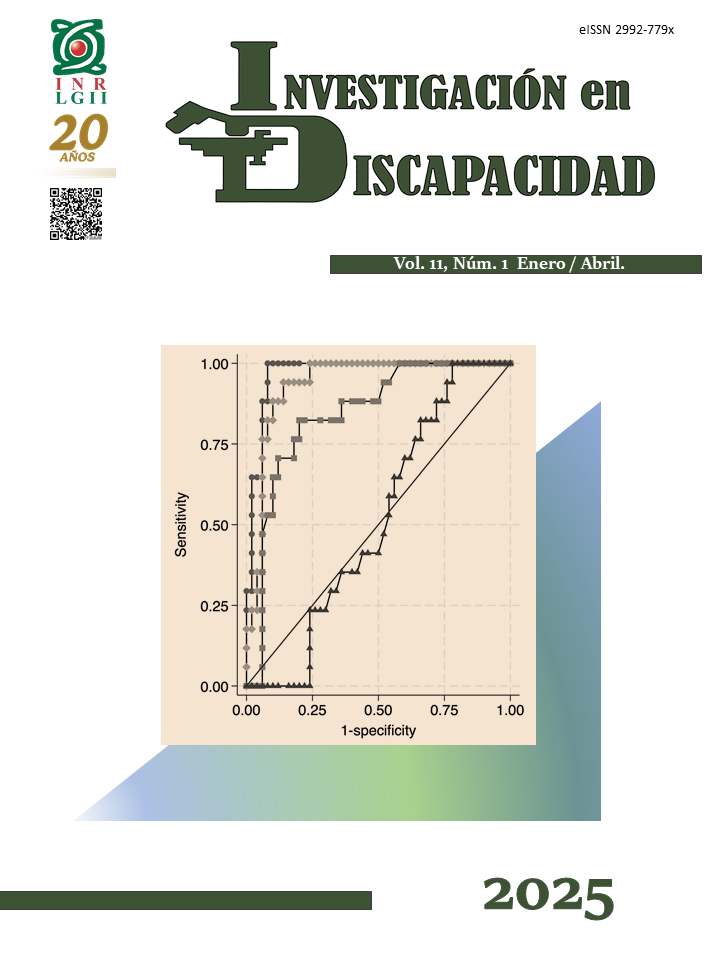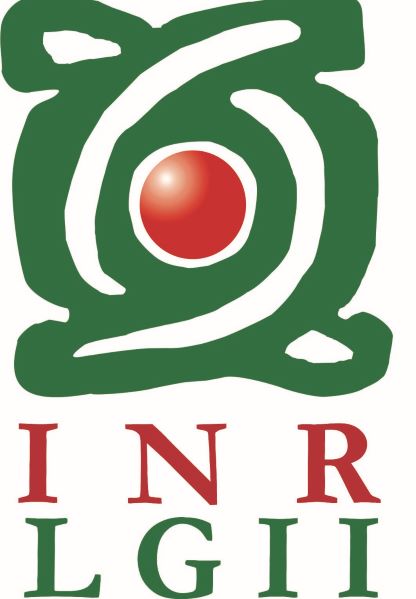Electrophysiologic correlations and diagnostic accuracy of quantitative surface electromyography in median neuropathy.
DOI:
https://doi.org/10.35366/120412Keywords:
surface electromyography, electrodiagnosis, Quantitative evaluation, Median neuropathyAbstract
Introduction
Quantitative electromyography (QEMG) is an objective methodology for analyzing maximum effort phase of an electromyography (EMG) recording. The signal is decomposed in time domain and frequency domain variables that offer numerical values for analyzing. QEMG using surface electrodes may be useful in distinguishing abnormal patterns in peripheral nerve diseases.
Objective: Describe the diagnostic accuracy using ROC curve analysis of the quantitative variables of surface EMG interference pattern (IP) in patients with carpal tunnel syndrome (CTS).
Material and Methods: 32 patients (50 hands) with electrophysiological diagnosis of CTS were compared with 14 patients (17 hands) without CTS. The IP of abductor pollicis brevis (APB) was obtained with a 10 second contraction, QEMG analysis was performed using time domain variables and frequency domain variables.
Results. Mean amplitude of turns was lower and T/M ratio was higher in CTS group compared with non-CTS (p<.001). On frequency domain, RMS (p<.001)and power of peak frequency (p<.05)was lower on CTS group . Differences remained significant when an analysis matched by age was performed. ROC curve analysis showed an AUC of 0.96 for RMS and 0.93 for mean amplitude of turns.
Conclusion: Maximum effort in EMG can be described with quantitative variables of the IP using superficial electrodes. Mean amplitude of turns and RMS obtained through surface EMG have high diagnostic accuracy for distinguishing between neuropathic and non neuropathic patterrns.
Publication Facts
Reviewer profiles N/A
Author statements
Indexed in
- Academic society
- N/A
References
References.
-De Luca CJ, LeFever RS, McCue MP, Xenakis AP. Behaviour of human motor units in different muscles during linearly varying contractions. J Physiol. 1982 1;329(1):113–28. doi: 10.1113/jphysiol.1982.sp014293
-De Luca CJ, LeFever RS, McCue MP, Xenakis AP. Control scheme governing concurrently active human motor units during voluntary contractions. J Physiol. 1982 Aug 1;329(1):129–42. doi: 10.1113/jphysiol.1982.sp014294
-Stålberg E, van Dijk H, Falck B, et al. Standards for quantification of EMG and neurography. Clin Neurophysiol. 2019;130(9):1688-1729. doi:10.1016/j.clinph.2019.05.008
-Sanders DB, Stalberg EV, Nandedkar SD. Analysis of the electromyographic interference pattern. J Clin Neurophysiol 1996;13:385–400. doi:10.1097/00004691-199609000-00003
-Seddon HJ: Surgical Disorders of the Peripheral Nerves. Baltimore: Williams & Wilkins, 1972,
-Fuglsang-Frederiksen A. The utility of interference pattern analysis. Muscle Nerve. 2000 Jan 1;23(1):18–36. doi:10.1002/(sici)1097-4598(200001)23:1<18::aid-mus4>3.0.co;2-b
-Fuglsang-Frederiksen A, LoMonaco M, Dahl K. Integrated electrical activity and number of zero crossings during a gradual increase in muscle force in patients with neuromuscular diseases. Electroencephalogr Clin Neurophysiol 1984;58:211–9.Doi:10.1016/0013-4694(84)90106-8
-Willison RG. Analysis of electrical activity in healthy and dystrophic muscle in man. J Neurol Neurosurg Psychiatry . 1964 Oct;27(5):386-94. doi: 10.1136/jnnp.27.5.386.
-Stålberg E, Chu-Andrews J, Bril V, Nandedkar SD, Stålberg S, Ericsson M. Automatic analysis of the EMG interference pattern. Electroencephalogr Clin Neurophysiol 1983;56:672–81.doi:10.1016/0013-4694(83)90035-4
Liguori R, Dahl K, Fuglsang-Frederiksen A, Trojaborg W. Turns-amplitude analysis of the electromyographic recruitment pattern disregarding force measurement. II. Findings in patients with neuromuscular disorders. Muscle Nerve . 1992; 15(12):1319–24. doi:10.1002/mus.880151205
Nirkko AC, Rösler KM, Hess CW. Sensitivity and specificity of needle electromyography: a prospective study comparing automated interference pattern analysis with single motor unit potential analysis. Electroencephalogr Clin Neurophysiol. 1995; 97(1):1—10. doi:10.1016/0924-980x(94)00248-6
-Fuglsang-Frederiksen A, Mansson A. Analysis of electrical activity of normal muscle in man at different degrees of voluntary effort. J Neurol Neurosurg Psychiatry 1975;38:683–9. doi: 10.1136/jnnp.38.7.683
-Nandedkar SD, Sanders DB, Stålberg E. Automatic analysis of the elctromyographic interference pattern. Part I: Development of quantitative features. Muscle Nerve 1986a;9:431–9. doi: 10.1002/mus.880090508
-Nandedkar SD, Sanders DB, Stalberg EV. Simulation and analysis of the electromyographic interference pattern in normal muscle. Part II: Activity, upper centile amplitude and number of small segments. Muscle Nerve 1986b;9:486–90.
DOI: 10.1002/mus.880090603
-Fuglsang-Frederiksen A, Lo Monaco M, Dahl K. Turns analysis (peak ratio) in EMG using the mean amplitude as a substitute of force measurement. Electroencephalogr Clin Neurophysiol 1985;60:225–7. doi: 10.1016/0013-4694(85)90035-5
-Finsterer J. EMG-interference pattern analysis. J Electromyogr Kinesiol. 2001;11(4):231-246. doi:10.1016/s1050-6411(01)00006-2
-Fuglsang-Frederiksen A. Power spectrum of the needle EMG. Methods Clin Neurophysiol 1990;2:1–8. DOI:10.1016/0022-510x(90)90100-2
-Fuglsang-Frederiksen A, Ronager J. The motor unit firing rate and the power spectrum EMG of humans. Electroencephalogr Clin Neurophysiol 1988;70:68–72.
doi: 10.1016/0013-4694(88)90196-4.
-Werner RA, Andary M. Electrodiagnostic evaluation of carpal tunnel syndrome. Muscle Nerve. 2011;44(4):597-607. doi:10.1002/mus.22208
-Weiss L, Carpal Tunnel Syndrome in Weiss J,Weiss L, Silver J, editors. Easy Emg: A Guide to Performing Nerve Conduction Studies and Electromyography 2nd edition. Elsevier; 2015 p. 111-117.
-Rønager J, Christensen H, Fuglsang-Frederiksen A. Power spectrum analysis of the EMG pattern in normal and diseased muscles. J Neurol Sci. 1989 Dec 1;94(1):283–94. doi:10.1016/0022-510X(89)90237-2
-Marco G, Alberto B, Taian V. Surface EMG and muscle fatigue: multi-channel approaches to the study of myoelectric manifestations of muscle fatigue. Physiol Meas. 2017;38(5):R27-R60. doi:10.1088/1361-6579/aa60b9
-Krarup C. Compound sensory action potential in normal and pathological human nerves. Muscle Nerve. 2004;29(4):465-483. doi:10.1002/mus.10524
-Tseng TJ, Hsiao TH, Hsieh ST, Hsieh YL. Determinants of nerve conduction recovery after nerve injuries: Compression duration and nerve fiber types. Muscle Nerve. 2015;52(1):107-112. doi:10.1002/mus.24501
-Hagberg M, Ericson BE. Myoelectric power spectrum dependence on muscular contraction level of elbow flexors. Eur J Appl Physiol 1982;48:147–156.doi: 10.1007/BF00422976
-Zwarts MJ, Stegeman DF. Multichannel surface EMG: basic aspects and clinical utility. Muscle Nerve. 2003;28(1):1-17. doi:10.1002/mus.10358
-Smith CM, Housh TJ, Zuniga JM, Camic CL, Bergstrom HC, Smith DB, et al. Influences of interelectrode distance and innervation zone on electromyographic signals. Int J Sports Med 2017;38:111–7.doi: 10.1055/s-0042-119398
- Fuglsang-Frederiksen A, Scheel U, Buchthal F. Diagnostic yield of analysis of the pattern of electrical activity and of individual motor unit potentials in myopathy. J Neurol Neurosurg Psychiatry 1976;39:742–750.DOI: 10.1136/jnnp.39.8.742
-Haig AJ, Gelblum JB, Rechtien JJ, Gitter AJ. Technology assessment: the use of surface EMG in the diagnosis and treatment of nerve and muscle disorders. Muscle Nerve 1996;19:392–395.doi: 10.1002/(SICI)1097-4598(199603)19:3<392::AID-MUS21>3.0.CO;2-T
-Roeleveld K, Sandberg A, Stålberg EV, Stegeman DF. Motor unit size estimation of enlarged motor units with surface electromyography. Muscle Nerve 1998;21:878–886.doi: 10.1002/(sici)1097-4598(199807)21:7<878::aid-mus5>3.0.co;2-3
Downloads
Published
How to Cite
Issue
Section
License
Copyright (c) 2024 Instituto Nacional de Rehabilitación Luis Guillermo Ibarra Ibarra

This work is licensed under a Creative Commons Attribution 4.0 International License.
© Instituto Nacional de Rehabilitación Luis Guillermo Ibarra Ibarra under a Creative Commons Attribution 4.0 International (CC BY 4.0) license which allows to reproduce and modify the content if appropiate recognition to the original source is given.




